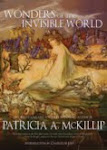.tif)
“THE TOURIST SHOPS OF PRAGUE SELL DOZENS OF ITEMS COMMEMORATING FRANZ KAFKA. You can drink a latte in the Café Kafka, add sugar to it from a packet with Kafka’s face on it, and then light your cigarette from a box of Kafka matches.
“Franz Kafka died in obscurity in 1936, publishing only a handful of bizarre stories in little known literary magazines. Yet today he persists in our collective imaginations. Even those who have never read any of Kafka’s fiction describe their tribulations with the Department of Motor Vehicles as “Kafkaesque” How did this happen?
“Kafkaesque explores the fiction of generations of authors inspired by Kafka’s work. These dystopic, comedic, and ironic tales include T.C. Boyle’s roadside garage that is a never ending trial, Philip Roth’s alternate history in which Kafka immigrates to America to date his aunt, Jorge Luis Borges’ labyrinthine public lottery that redefines reality, Carol Ernshwiller’s testimony by the first female to earn the right to call herself a “man,” and Paul Di Filippo’s unfamiliar Kafka—journalist by day, costumed crime fighter by night.
“Also included is Kafka’s classic story “The Hunger Artist,” appearing both in a brand-new translation and in an illustrated version by legendary cartoonist R. Crumb (Fritz the Cat). Additionally, each author discusses Kafka’s writing, its relevance, its personal influence, and Kafka’s enduring legacy.”
The stories listed below were some of the most bizarre but ingenious I have ever read. They work on repetitive themes Franz Kafka incorporated in his own work.
A Hunger Artist by Franz Kafka
The title introduces the topic of the unfolding story of a man on exhibition, fasting. Initially I wondered where it was going, and soon was mesmerized by the words and the story.
The Drowned Giant by J.G. Ballard
A rendition of Gulliver’s Travels with macabre twists.
The Cockroach Hat by Terry Bisson
Love, death and misdirection as told in an alternate reality by a cockroach.
Hymenophera by Michael Blumlein
A clothes designer discovers an eight-foot wasp in his salon.
The Lottery in Babylon by Jorge Luis Borges
As was in Babylon of old with wanton and unusual tastes, the lottery fulfilled most of the buyers’ dreams with its prizes.
The Big Garage by T. Coraghessan Boyle
An Audi owner joins three bedraggled car owners living in a garage while waiting for repairs that may never come.
The Jackdaw's Last Case by Paul Di Filippo
A journalist turns crime fighter by night in Kafaesque style.
Report to the Men’s Club by Carol Emshwiller
A feminine take on living in a patriarchal society.
Bright Morning by Jeffrey Ford
An escape story with a twist, of a fantasy/science fiction writer implementing Kafka elements.
The Rapid Advance of Sorrow by Theodora Goss
A surreal look at communism in eastern Europe.
Stable Strategies for Middle Management by Eileen Gunn
Bioengineering has its disadvantages when applying insect genes to facilitate organizational abilities.
The Handler by Damon Knight
A story difficult to interpret except to stay it has the aspect of a Trojan horse.
Receding Horizon by Jonathan Lethem & Carter Scholz
A parody on “It’s A Wonderful Life”.
A Hunger Artist by David Mairowitz and Robert Crumb
A pictorial version of the story by Franz Kafka.
“I Always Wanted You to Admire My Fasting” or, Looking at Kafka by Philip Roth
Humourous reminiscences of a boy’s Hebrew-school teacher being invited to dinner.
The 57th Franz Kafka by Rudy Rucker
Not my type of story. Someone else may find it entertaining.
The Amount to Carry by Carter Scholz
An insurance broker composes music meets Mr. Kafka of Workman’s Accident Insurance Institute.
Kafka in Bronteland by Tamar Yellin
In reflection of her Jewish upbringing, a Yorkshire woman encounters Kafka on the moors.
JOHN KESSEL and JAMES PATRICK KELLY are the award winning co-editors of canon-defining anthologies, including Feeling Very Strange, The Slipstream Anthology, Rewired: The Post-Cyberpunk Anthology, and The Secret History of Science Fiction.
The review copy was provided by Charlene Brusso, with many thanks.
Book format: paperback, 288 pages
Publisher:
Tachyon Publications
Available:
amazon.com
chapters.indigo.ca




.tif)














